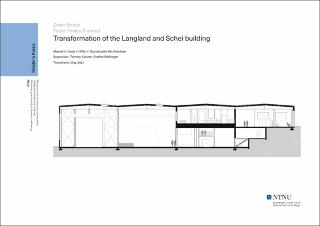| dc.contributor.advisor | Kleiven, Tommy | |
| dc.contributor.advisor | Wellinger, Steffen | |
| dc.contributor.author | Trulsrud, Tonje Healey | |
| dc.contributor.author | Brudal, Ørjan | |
| dc.date.accessioned | 2021-09-14T16:01:57Z | |
| dc.date.available | 2021-09-14T16:01:57Z | |
| dc.date.issued | 2021 | |
| dc.identifier | no.ntnu:inspera:85025858:46839402 | |
| dc.identifier.uri | https://hdl.handle.net/11250/2776571 | |
| dc.description.abstract | Denne masteroppgaven som helhet ser på mulighetene ved en transformasjon av industribygget Langland & Schei på Reina i Trondheim. Bygget er fra 1960-tallet og har fungert som et maskinverksted. Oppgaven har til hensikt å undersøke verdien av transformasjon og gjenbruk av bygget, fra et bærekraftperspektiv. Bygningsmaterialer har store mengder klimagassutslipp bundet. Derfor er det essensielt å renovere og transformere eksiterende bygg i stedet for å rive, med konsekvens av at store mengder materialer sendes til deponi.
Rammeverket er delt in i et arkitektonisk konsept og en klima og bærekraftsanalyse. Utformingen av arkitekturkonseptet er basert på forskning, diskusjoner og simuleringer, med hovedvekt på miljøvennlig og sosial bærekraft. Formålet med klima og miljø analysen er å evaluere bærekraftigheten og konsekvensene av design valgene. Metoden for utredningene er livssyklusanalyser.
Egenskapene til konstruksjonen kan brukes som en veileder for transformasjonen. Prinsipper som tilpasningsevne og design for uorden kan brukes for å forbedre fleksibiliteten til et bygg. Livssyklusanalyser viser at en transformasjon av et industribygg til et flerbruksbygg er fordelaktig med tanke på klimagassutslipp i forhold til et nybygg i tre. Klimagassutslippene for referansebygget er tre ganger så store som transformasjonen for A1-A3. Videre er klimagassutslippene 12 % lavere for å utforme bygget etter NS 3700 Passivhus standarden i forhold til TEK 17 for kontordelen av bygget. | |
| dc.description.abstract | This master thesis studies the possibilities of a transformation of the industrial building Langland & Schei at Reina in Trondheim. It is a building from the 1960’s, which has served as a mechanical workshop. The thesis seeks to investigate the value of transforming and reusing the building, from a sustainable context. Building materials have large amounts of embodied energy and possible GHG emissions. Therefore, renovating and transforming existing buildings instead of demolishing, is critical in order to act according to environmental issues.
The framework is divided into an architectural concept and environmental assessment. The development the architectural concept is based on research, discussions and simulations, with a strong emphasis on environmental and social sustainability. The purpose of the environmental assessment is to evaluate the sustainability and consequences of the design choices. The method used is a Life Cycle Assessments (LCA).
The properties of the structure can be used as a guide for the transformation. Using principles such as design for disorder and adaptability can enhance the flexibility of the building. LCA results show that an adaptive reuse of the industrial building to a mixed-use building is favorable in terms of embodied GHG emissions compared to a new building in wood. The GHG emissions for the reference building are three times as large as the transformation design for A1-A3. The GWP is 12 % lower for designing according to NS 3700 Passive House standards compared to TEK17 for the office part of the building. | |
| dc.language | eng | |
| dc.publisher | NTNU | |
| dc.title | Transformation of the Langland and Schei building | |
| dc.type | Master thesis | |
